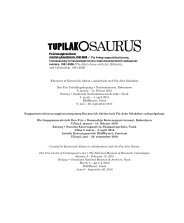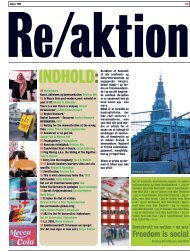tupilakosaurus - Print matters!
tupilakosaurus - Print matters!
tupilakosaurus - Print matters!
You also want an ePaper? Increase the reach of your titles
YUMPU automatically turns print PDFs into web optimized ePapers that Google loves.
Itsarujussuarnisamik Kap<br />
Stosch-imeersumik soqutiginartumik<br />
paasiniaaneq;<br />
aamma Qulequtaqanngitsoq<br />
(Saaneq)). 1999<br />
Saqqummersitsinissaq sioqqullugu Arke<br />
oqaluttuarpoq: “Periaasera soorlu ilisimatusarnerit<br />
assilialiornerillu tamarmik<br />
iluanni pisartutut aalajangersimasumik<br />
takutitsiniartuuvoq, uani pineqarluni Kalaallit<br />
Nunaata ilisimatusarfigineqarnerata<br />
oqaluttuassartaa. Illutaat inuillu tassunga<br />
tunngasut ornittarpakka. Taamaaliorninni<br />
isummiutama ilagaat paasiniarniarlugu ilisimasaqarneq<br />
ilisimasaqannginnerlu qanoq<br />
naleqqiunneqarsinnaanersut. Tassami suna<br />
ilisimasariaqarparput assiliaq takusinnaajumallugu?<br />
Ilisimasaqarnissarput pisariaqarpa?<br />
Ilisimasaqartariaqarpugut?”<br />
Videop saniani takoqqippavut pappialat<br />
assilissanik kukkunersiuinermut atortussiat<br />
Taamaallat kullumik eqeqqumillu<br />
attugassaq-mut atugassaq naammasseriigaq.<br />
Qulequtaa tupilammik oqaluttuameersoq<br />
eqqumiissorinarpoq pisariillisaanermut<br />
ilisimasaqarnermullu, Nielsenip<br />
nalunaarusiaatigut ersersinneqartumut,<br />
naleqqiullugu. Qulequtaa oqaluttuatoqarlu<br />
tassaniissinnaanngilluinnarput.<br />
Ajaappiaq-mi aamma Kaataq-mi naammagisimanngilaa<br />
assilissat allaatigisamit<br />
avissaartiinnarnissaat. Assiliartaattaaq<br />
qiortarsimavai katiteqqillugillu nutaanik<br />
nangittunik assilialiorsimalluni oqaluttuartalerlugit,<br />
taamalu katersugaasivimmiippalaartilerlugit<br />
sinilerlugit sinaata killingani<br />
qaqortortalerlugit. Qanoq pisoqassava assiliartaat<br />
kisiisa isigilerutsigik? Minnerunngitsumillu<br />
assilissat ujarassiuup qangarsuarli<br />
nalunaarusiaanit sunatik toqqorsivimmiittutoqqanit<br />
aaneqarsimappata kusanartuliornerullu<br />
silarsuaanut eqqullugit?<br />
Kalaallit inuiattut eqqaamasaasa Tunullu<br />
avannaani ujaranngornikup grækerit ilisimatusartut<br />
taaguusiisarneri kattullugit<br />
Nielsenip atsiineratigut – tupilak-o-saurus!<br />
– Arkep takulerpai sukujuit, eqqumiitsuliortutut<br />
atorsinnaallugit Kitaamiut<br />
nunarsuarmik isiginninnerannut oqaluttuarisaanermillu<br />
allannerannut pulanissaminut<br />
tinnersaanissaminullu. Taava<br />
imminut “o”-jutilerpoq, tassanngaanniimmi<br />
Kalaallit Nunaannik misissuilluartut<br />
misissuilluarluni uliingaatsiar-lugillu<br />
isigisinnaaniassagamigit.<br />
Mirjam Joensen & Kuratorisk Aktion<br />
Pia Arke. An installation that has to with histories<br />
(The Measuring Stick; The Hammer; May only be<br />
touched with thumb and little finger; Tupilakosaurus:<br />
An interesting study about the triassic myth of<br />
Kap Stosch; Untitled (The Bone)). 1999<br />
In connection with the installation<br />
An installation that has to do with<br />
histories (1999) Arke gets hold of<br />
proofs for the illustrated part of<br />
Dr. Eigil Nielsen’s Tupilakosaurus<br />
heilmani n. g. et n. sp. An interesting<br />
batrachomorph from the Triassic of<br />
East Greenland and takes his treatise<br />
– which was published in 1954 as<br />
part of the series of scientific monographs<br />
Meddelelser om Grønland –<br />
under tender artistic treatment.<br />
What seems to have fascinated<br />
Arke about the study is especially<br />
Nielsen’s naming of a 200-millionyear-old<br />
stegocephalia after the<br />
Greenlandic myth of the Tupilak<br />
monster. For her this was a crucial<br />
statement about how rather than<br />
being an untouched and pure place<br />
Greenland is a construction created<br />
by all the finds, descriptions, pictures,<br />
mappings and colonisations<br />
that Western and especially Danish<br />
explorers, missionaries and colonisers<br />
have brought about in the<br />
country. As she wrote to the<br />
museum where she was due to<br />
exhibit: “[I want both] to get hold<br />
of the larger structures in Danish<br />
research history on Greenland, and<br />
conversely to dive down into the<br />
deeper layers in the actual word<br />
Tupilakosaurus … One in Tupilak,<br />
which belongs to the era before the<br />
Christianising of Greenlanders and<br />
their mythical world. The other<br />
Saurus, which from a more scientific<br />
viewpoint has to do with the<br />
history of the world’s creation.”<br />
So, in the video Tupilakosaurus<br />
the artist visits the Geological<br />
Museum in Copenhagen, where she<br />
patiently listens to the head of department’s<br />
somewhat arid account<br />
about his predecessor and model<br />
Eigil Nielsen. A story filled with<br />
Latin classifications concerning the<br />
finding of a Triassic vertebrate in<br />
North East Greenland. The camera<br />
cross-cuts to the artist, who is<br />
firmly handling and stacking the<br />
proof sheets for Nielsen’s treatise<br />
at the same time as we hear a reading<br />
of the Tupilak myth, which has<br />
to do with a shaman who, briefly<br />
related, makes a tupilak from various<br />
animal and human bones (and<br />
other more vital parts), after which<br />
he gives it life so that it acquires<br />
supernatural powers. The parallel<br />
to the above-described construction<br />
of Greenland is striking.<br />
Arke said prior to the exhibition:<br />
“As in all research and visual art<br />
my method will be to objectivise, in<br />
this case, the history of research on<br />
Greenland. I visit its premises and<br />
the people who are connected with<br />
it. My idea here is, among other<br />
things, to investigate the relation<br />
between knowledge and non-knowledge.<br />
Because what is it we need<br />
to know to see images? Do we need<br />
to know anything? Do we have to<br />
know anything?”<br />
On the floor next to the video<br />
we again meet the piles of picture<br />
proofs in the form of the ready-made<br />
May only be touched with thumb<br />
and little finger. The title, which has<br />
been taken from the Tupilak myth,<br />
seems absurd in relation to the idea<br />
of rationality and knowledge that<br />
Nielsen’s study represents. The title<br />
and even more so the myth cannot<br />
be contained in it.<br />
In The Measuring Stick and<br />
The Hammer Arke has not merely<br />
separated the images from the study<br />
itself. She has also cut them out<br />
and put them together to make new<br />
series of images and narratives that<br />
are now displayed in museological<br />
fashion with passepartouts and<br />
frames. What happens when we are<br />
left to the images in themselves? And<br />
not least when they are taken out of<br />
an old geological dissertation passively<br />
put away in a storeroom and<br />
are brought into the space of art?<br />
In Nielsen’s mixture of the<br />
Greenlandic-folkloric and the<br />
Greek-scientific in the naming of<br />
the Northeast Greenlandic fossil –<br />
tupilak-o-saurus! – Arke detected a<br />
mishmash that she could use in order<br />
to insert herself artistically and<br />
give a push to the world images<br />
and history writing of the West.<br />
She took, so to speak, the place of<br />
the “o” in the name as a position<br />
from which to cast an investigatory<br />
and rather revelatory eye on those<br />
who investigate Greenland.<br />
Mirjam Joensen & Kuratorisk Aktion<br />
21




